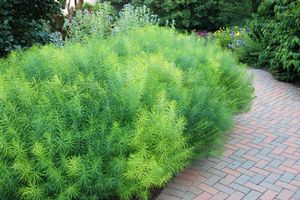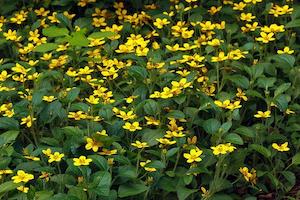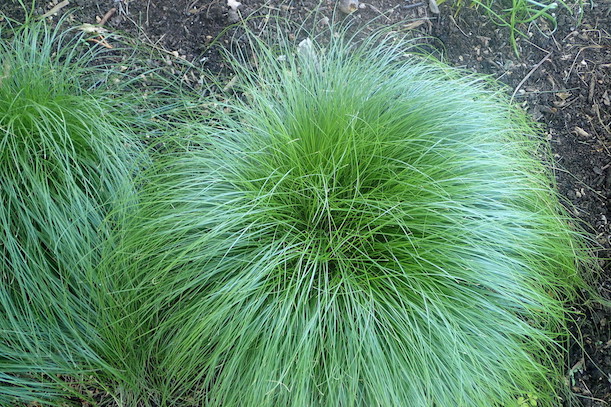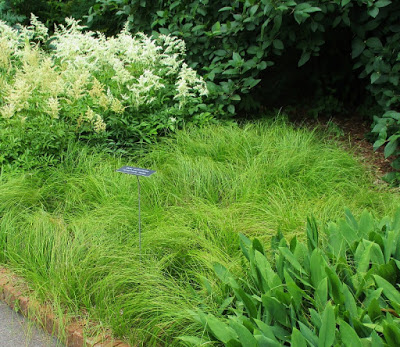Ground Cover or Cover Your Ground
by Jennifer Naughton, Fairfax Master Gardener

Amsonia hubrichtii
Land is the only thing that lasts. Or so, Americans once said. From Margaret Mitchell’s fictional ‘Tara” to Theodore Roosevelt’s preservation of national park space, a mythical love of land is rooted in the American imagination. Yet, American land is slowly vanishing. Rising sea levels are submerging shorelines. Major rain events are washing nutrient rich topsoil into waterways. Developers are gobbling up green spaces, forests and countryside into a swath of impermeable space.
To preserve land integrity, small but united efforts across residential lot lines can make a difference. Homeowners, more than farms or industry, hold underutilized power in changing environmental practices harming American land. Turfgrass is the most irrigated crop in America with billions of pounds of fertilizer and pesticide utilized per year and billions spent on lawn care. If you add to that number, dollars spent on irrigating, fertilizing and mulching ornamental garden beds, it is clear that the process of caring for our residential land is wasteful and full of misuse. All this effort, time and money to send clean water with excess chemicals down the drain as toxic run-off into our waterways, harms life on land and water alike.

Chrysogonum virginianum – a native
It is time to let go of ideology from 17th- and 18th-century Europe of lawn as the aristocratic status symbol and reorient our perspectives and our landscapes to a new idea of how to cover our ground. Gardeners understand that ground cover can provide an initial, first level in a garden bed that gradually grows taller with perennials, shrubs and trees. But, ground cover is more than a front-of-the-border plant that adds layers to your landscape. If chosen wisely, suitable to its environment, native and low in maintenance needs, it can serve as green mulch — better even than leaf mold that adds organic matter as it decomposes. Green mulch holds soil in place. Green mulch aerates soil allowing water to percolate the ground. Green mulch serves beneficial insects. And green mulch cools soil and retains moisture. In other words, green mulch maintains soil, keeping it in the yard where you want it and keeping it healthy.

Phlox subulata
As you design garden beds, consider where you can sneak in more ground cover. The sprawling Amsonia hubrichtii has pockets of bare earth beneath. Ephemerals like Mertensia virginica will vanish come May. Tall, vertical perennials that play a structural role such as Eutrochium purpureum leave room at their base. Symphyotrichum lateriflorum won’t fully form until late summer, and the earth will remain exposed through winter if cut back. Bed depth is layered, but so is bed height. Ground cover brings seasonal interest, texture and perhaps flowering, when other plants are not putting on their show. If chosen wisely and adaptable to shade, they can sit quietly when larger perennials bloom and cool roots keeping companion plants less stressed and healthier. They can also provide movement throughout the garden bed and enhance your legible design. After they fill in, weed suppression makes for less toil.
Choices for ground cover are endless and depend on environment and aesthetic needs. To keep hold of the soil in your yard, provide evergreen cover and integrate a first layer of natives in your landscape, consider the following.
With its cheerful, upright yellow April bloom, Packera aurea is adaptable, but best suited for medium to wet soil, with sun to part shade. Its thick foliage hints at its aggressive nature, so contain it in an area with paved borders or with a watchful eye. Another spring bloomer with a shorter, yellow daisy-like flower and more easily controlled is Chrysogonum virginianum, which also forms a dense mat and works well in part shade to shade, and medium to wet soils. If you are lucky and it is not too hot, Chrysogonum will flower from early spring to summer. Both plants are recommended for rain gardens.

Carex Rosa
For drier sites, Phlox subulata is mat-forming, vigorous and especially suited under late season perennials. From April to June, Phlox will flower rose, pink or white and in summer heat, remain happily cooled and protected, shaded by taller plants. Provide a lower layer in a wooded setting with Heuchera americana and Heuchera villosa. Both tolerate drought once established and appreciate afternoon shade. Although these two ground covers are not vigorous spreaders, they offer seasonal interest with airy flower panicles remaining in winter and look striking when massed. Of the two, H. villosa is perhaps superior with its velvety, broad leaves and larger, gracious form.
Some favorite ground covers are sedges. Although flowering is insignificant, they provide a tidy appearance around other blooming perennials and offer a chance to play with foliage hue and texture. Some have yellow or blue tones, some are broad-leaved, and others are wispy and light in the garden. An added bonus is the root mass and depth that assist rainwater in infiltrating the soil. Carex strica is one such example, boasting more biomass below ground than above. Its fountain-like habit is 1 to 3 feet tall (0.5 to 1 m), and it easily naturalizes and prevents erosion. A smaller, option is Carex rosea whose 1-foot-tall (30 cm) form tolerates both dry and moist conditions from full sun to partial shade. Carex pensylvanica, the smallest and most adaptable, grows in sun to shade, dry to moist, as it naturalizes and enriches the soil. C. pensylvanica can serve as a substitute for turfgrass and fills in an open space nicely with its rhizomatous and self-seeding nature.

Carex pensylvanica
If you are looking for a sedge with thicker, broader leaves similar to a liriope, compare Carex flaccosperma and Carex glaucodea. Both have lovely blue-green tones. C. flaccosperma grows in medium to wet conditions in part to full shade and forms 6- to 10-inch-tall (15 to 25 cm) clumps. C. glaucodea prefers drier conditions. A third option, Carex laxiculmis, is more silvery blue and slightly larger at 12 inches (30 cm) tall. Lush and shaggy, C. laxiculmis prefers moist to wet conditions in part to full shade.
Covering your ground can feel like a daunting task. The expense of planting enough ground cover to blanket garden beds or substitute turfgrass is initially expensive. There are economical options to make this work. Local native plant nurseries sell trays of plugs or purchase larger gallon-size plants and divide them into smaller clumps to stretch your dollar. Choose ground covers that spread and self-seed. Or dig up and exchange your profuse ground covers with a friend or at a plant swap.
The positive impact on the environment and the aesthetic of creating space as nature intended holds intrinsic value. That initial layer in the landscape, ground cover, is a fundamental first step in creating a healthy and diverse ecosystem in your own yard. Be generous with it and you’ll reap rewards. Peel back a corner and take a look at the rich dirt beneath. It’s your land, it’s our land, a precious and dwindling resource.
-
References
- Groundcovers: Lush Carpet For Your Garden, Elaine Homstad, Fairfax Master Gardeners
- Earth Sangha Wild Plant Nursery, Springfield, VA
- Watermark Woods Native Plants, Hamilton, VA
- Biggest irrigated crop? The American lawn, Michigan Farm News. October 10, 2016
- From Lawn to Meadow, Pennsylvania Land Trust Association
- Lawns vs Crops in the Continental U.S., Francie Diep, Scienceline – a project of NYU’s science, health and environmental reporting program, July 3, 2011
- Tussock Sedge, A Restoration Superplant?, University of Wisconsin, September 22, 2010